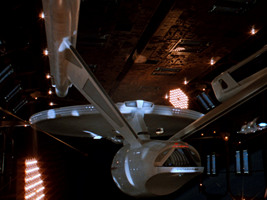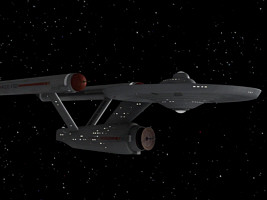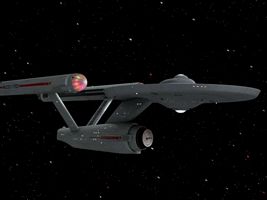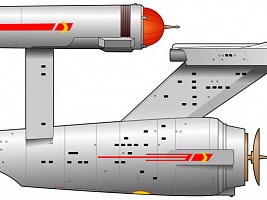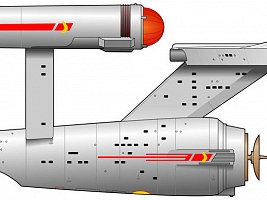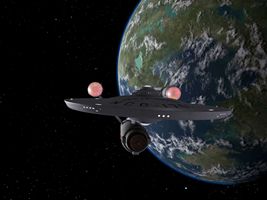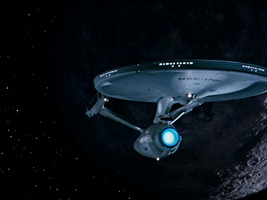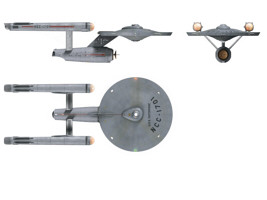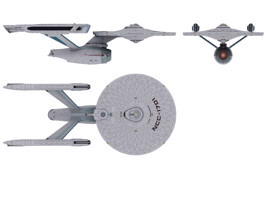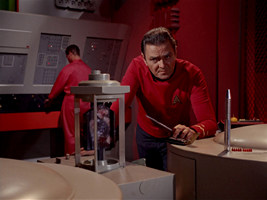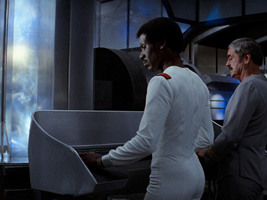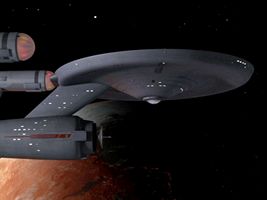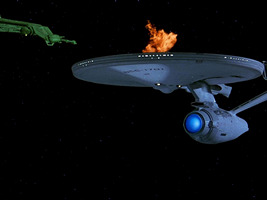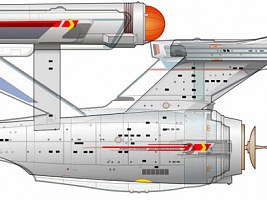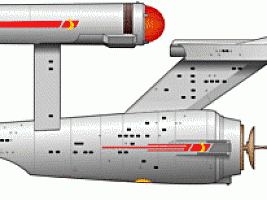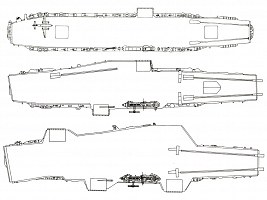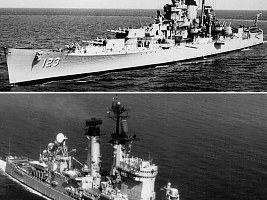The Enterprise Refit of 2271
 The DIS/SNW reboot of the Enterprise is not discussed here. See the database on Discoverse Federation Ship Classes.
The DIS/SNW reboot of the Enterprise is not discussed here. See the database on Discoverse Federation Ship Classes.
More than ten years after the end of The Original Series, a new and more detailed filming miniature of the USS Enterprise debuted in the first feature film of the franchise, "Star Trek: The Motion Picture". The new ship was designed by Andrew Probert, based upon Mike Minor's and Joe Jennings's concepts for the abandoned series Phase II. It retained only the basic arrangement of the major components (saucer, engineering hull and nacelles) of the starship from the TV series. The in-universe explanation provided in the movie is that the Enterprise underwent a refit after the five-year mission that was so extensive that Admiral Kirk would have trouble finding his way when he comes aboard. The question is if this rationale is visually and technically possible and if the new Enterprise can still pass as the same ship.
In-Universe Design History
Previous refit
 There is no canon evidence in any episode, but according to the Star Trek Encyclopedia the original starship Enterprise NCC-1701 was launched in 2245 (discounting Admiral Morrow's claim in "Star Trek III" that the ship was just 20 years old in 2284, which can't be true). We can see the ship under the command of Captain Pike in the year 2253 in the pilot episode "The Cage". Aside from a few minor changes, the Enterprise still has the same configuration under Captain Kirk in 2265, as seen in the second pilot TOS: "Where No Man Has Gone Before".
There is no canon evidence in any episode, but according to the Star Trek Encyclopedia the original starship Enterprise NCC-1701 was launched in 2245 (discounting Admiral Morrow's claim in "Star Trek III" that the ship was just 20 years old in 2284, which can't be true). We can see the ship under the command of Captain Pike in the year 2253 in the pilot episode "The Cage". Aside from a few minor changes, the Enterprise still has the same configuration under Captain Kirk in 2265, as seen in the second pilot TOS: "Where No Man Has Gone Before".
 The ship was refurbished some time between in 2265/66 to the familiar TOS version. There are modifications to the deflector dish, the side walls of the engineering hull, the nacelle spires, the nacelle aft ends and the bridge module from the pilot to the series version of the studio miniature. Also, while the crew complement was said to be 200 under Captain Pike in "The Cage", it increased to 400 crew members under Captain Kirk in the first season of TOS. It is a minor point that some instruments on the main bridge and the colors of the bridge were modified too during this time, for this can be accomplished in very brief time and doesn't necessarily point to an overall refit. As the change of its exterior insinuates, it seems to be a completely new bridge module anyway.
The ship was refurbished some time between in 2265/66 to the familiar TOS version. There are modifications to the deflector dish, the side walls of the engineering hull, the nacelle spires, the nacelle aft ends and the bridge module from the pilot to the series version of the studio miniature. Also, while the crew complement was said to be 200 under Captain Pike in "The Cage", it increased to 400 crew members under Captain Kirk in the first season of TOS. It is a minor point that some instruments on the main bridge and the colors of the bridge were modified too during this time, for this can be accomplished in very brief time and doesn't necessarily point to an overall refit. As the change of its exterior insinuates, it seems to be a completely new bridge module anyway.
Side note Additionally, the Enterprise engine room was modified some time in the second TOS season and a dilithium chamber was added, among a couple of other changes. Since the overall dimensions remained almost identical, it was definitely supposed to be still the very same room. It may have been the original intention that engineering was located in the saucer, just ahead of the impulse engines, thus the red glowing tubes in the background. However, plausibility requires the engine room to be inside the engineering hull and closer to the warp pylons, considering that the dilithium chamber is an essential part of the warp drive.
Refit of 2271
 After 25 years in service and only five years since the last refit, a very extensive refit of the ship took place from 2269 (when Kirk's five-year mission had just ended) to 2271 (when the ship was relaunched in "Star Trek: The Motion Picture"). The overall appearance of the Enterprise remained only roughly the same, few components seem to be left of the old ship.
After 25 years in service and only five years since the last refit, a very extensive refit of the ship took place from 2269 (when Kirk's five-year mission had just ended) to 2271 (when the ship was relaunched in "Star Trek: The Motion Picture"). The overall appearance of the Enterprise remained only roughly the same, few components seem to be left of the old ship.
Enterprise-A
The refitted Enterprise was destroyed in 2285, as seen in "Star Trek: The Search for Spock". One year later, in "Star Trek: The Voyage Home", a new USS Enterprise with the registry NCC-1701-A was commissioned. Its design was outwardly identical to the previous ship of the name, except for the number. Since it seems unlikely that an all-new ship was built in this "old" configuration, the most common assumption is that an existing vessel of the Constitution class refit got renamed. The Star Trek Encyclopedia II mentions in a side note that the ship was the USS Yorktown, but this is just speculation.
Comparison of Original and Refit
All the following dimensions were measured on 1/1200 scale diagrams of the two ships, assuming an overall length of 289m for the original version and 305m for the refit. There might be insignificant errors in my measurements as well as in the schematics.
Nacelles
The most noticeable modification is that the old cylindrical nacelles (length: 156m, diameter: between 13.4m and 16.2m) were replaced with new angular ones (length: 152m, width: 12m, height: 15.6m). Since rather the propulsion technology than merely the shell of the engines would be subject to change, we may safely conclude that the warp coils and everything else inside the nacelles are new as well. It is questionable anyway whether the old components would still fit into the new and somewhat smaller housing. The new glowing warp field grille (visible on the inward sides) is another sign that there are new warp coils. The most obvious evidence, however, is that the Miranda class seems to employ exactly the same nacelle type. No matter if the Miranda was developed before or after the Constitution refit, the nacelle looks like it is a new standard type and not a modification of the original Constitution nacelle.
Nacelle pylons
The warp nacelle struts are completely new too, and they are connected to the engineering hull much closer to the neck than before, indicating that there must be massive changes inside the engineering hull as well.
Engineering hull
The secondary hull was overall shifted backward (relative to the saucer) and only roughly retained its original shape. While the old one was essentially a conical cylinder (actually without the elegant curvature at its bottom that is visible in some drawn side views such as notably from the Fact Files), the new one is more rounded, like a wooden vat. The length of the engineering hull has increased from 99m to 111m, its maximum diameter by 4.6m. Interestingly the new, evidently "fatter" hull doesn't look like it is even longer than the old one. The true proportions are deceptive because the deflector dish was sticking out from the old hull, while the forward end is blunt on the new version. If we disregard the separate deflector dish on the old Enterprise, the two engineering hull forward ends are largely congruent, while it looks like just the shuttlebay has been extended to the rear, with a new, more sloped sliding door. Nevertheless, almost the complete outer surface must be new, since the two versions have hardly any hull plates with corresponding shapes. Thus, it is plausible that the windows are all new as well.
Pertaining to the interior of the secondary hull, the most obvious changes are that the shuttlebay was significantly enlarged (not on the later Enterprise-A where the shuttlebay as it is visible in "Star Trek V" looks like it is much smaller than even in TOS) and the ship now has a M/ARA occupying multiple decks. It is possible that the former engine control room did not include the actual warp core and thus looked very different. Yet, the dilithium chamber of the warp core itself or its load lock was located there at latest since 2268, as seen in TOS: "Elaan of Troyius". So it is clear that the old engine room doesn't exist any longer. Moreover, since the new warp pylons are sloped instead of running straight up from the hull, we have to assume that the path of the power transfer conduits inside the engineering hull has accordingly changed, and so would have the location of the warp core and main engineering. The absence of an external deflector dish would necessitate to move the whole sensor and other equipment backward.
Summarizing, the engineering hull could easily be a completely new structure, rather than a heavily modified part of the original Enterprise. Maybe something of the old structural frame is left, but it would be rather little of it, considering that the whole surface shape is different and the interior partition has noticeably changed too.
Neck
The connecting dorsal was not only modified by installing the double photon torpedo launcher with its rectangular housing. The new neck has about the same width (in the front view), and a possible small deviation in the range of less than 1m could easily be explained with either thicker or thinner hull layers on the new neck. All other dimensions, on the other hand, were significantly changed. The old neck was merely 24m long (in the side view) at its base at the engineering hull and 36m at the saucer bottom, while the new one measures 42m at both ends. Taking the distance between the centerline of the engineering hull and the underside at the saucer rim, the new neck is also 3.5m or one deck taller. The window locations, maybe even the deck heights, have been altered as well. It is obvious that not just the surface of the saucer, neck and engineering hull was renewed, but that these components were actually dis- and re-assembled. Like the engineering hull, the neck is either completely or mostly new.
Note Four windows in the neck that are vertically lined up along the turbolift shaft are congruent on the two neck versions. But since the surface is likely new, this may be regarded as a coincidence.
Saucer
The old saucer diameter measured 126m in diameter and was extended to 142m. The two decks in the new 8m thick ring around the saucer (well visible on the underside of the refit) might contain another corridor and/or a turbolift shaft and numerous staterooms, for instance. The rest of the surface remained largely the same. At least, we may presume that the structural frame underneath the hull plates was not changed. In particular, the central portion of the saucer, including the lower sensor dome, is exactly congruent if we presuppose 289m length for the original version and 305m for the refit. The saucer thickness (the height of the two large decks) remains the same as well. Actually, this perfect correspondence is the most important evidence for the relative sizes of all other components, whose proportions were more or less radically changed.
The details on the saucer surface, on the other hand, including the deflector grid, phaser emitters and windows are entirely new. The same applies to the sensor dome and the impulse engines. Unlike the neck, the saucer is large enough to allow the interpretation that its interior partition remained largely unchanged though. Even the spacious recreation deck visible in "Star Trek I" could always have been there and was just not shown in TOS. Nevertheless, it is undeniable that the internal equipment like wall, floor and ceiling panels and doors is new, owing to technical as well as "stylistic advancements", so that merely the basic floorplan may have been retained.
Bridge module
Since starship bridges are supposed to be interchangeable modules anyway, it is easy to explain that the new Enterprise has a new bridge module, again two decks tall, but now with two turbolift shafts. The floorplans of the two bridge modules are a bit different but this is rather a minor problem considering the many other changes.
Summary
The extensive modifications for the TMP Enterprise are summarized in an overlay image and in an animated sequence.
Real-Life Examples
USS Midway
Regarding vessels with a long lifespan, whose later refits looked only vaguely like the original version and more like newer classes, we can refer to the Midway class of the US Navy as a real-life example. The aircraft carrier USS Midway CV-41 (ex-CVA-41, ex-CVB-41) was commissioned in 1945 and went through a number of refits until she was retired in 1992. Among other modifications, the layout of the flight deck was radically changed and its area increased from the original to the final appearance of the ship. The later flight decks and many other parts of the ship arguably looked much more like those of the Forrestal CV-59 and the following supercarriers than like those of the Essex class, the vessels serving in WWII from which the Midway class was derived. The gradual refit of the Midway is not exactly the same that happened with the Starship Enterprise, but the final result is pretty much equivalent. Maybe the Enterprise just had overall longer overhaul cycles, and all the recent achievements were slated to be incorporated at once when the ship was literally taken apart around 2269.
USS Albany
An example of a vessel that was visually modified even more extensively and in one step is the USS Albany CA-123 that was converted from a heavy cruiser to a guided-missile cruiser from 1958 to 1962. The deck superstructures of the refit have almost nothing in common with the original version. The Albany (previously Oregon City class) became the lead ship of the new Albany class, and perhaps in the same vein the Enterprise (previously Constitution class) was the first ship of the Enterprise class, as a sign in the simulator room in "Star Trek II" insinuates.
Conclusion
Summarizing, most of the internal structure of the saucer and a bit of the engineering hull and neck of the original USS Enterprise could have survived the upgrade in 2271. Although these portions of the old ship may be left, it would be easier to explain the considerable differences with the Enterprise "refit" being actually a new ship of a new class. However, both versions are referred to as Constitution class (only the TOS dedication plaque says "Starship Class") and the movie dialogues (at least Kirk's lines) imply that this is still "his" Enterprise - with the same name and registry.
Matt Jefferies's original version of 2265 and Andrew Probert's new Enterprise of 1978 are both well-designed and very detailed and were prominently featured in the series and in the first six movies, respectively. The numerous differences are relevant and can't be simply explained by inaccurate presentation on screen, as it might be possible with alien ships. Therefore it seems necessary to accept that Starfleet built something very close to a new ship, but retained parts of the old ship - maybe to save costs. This may have sufficiently justified to keep up the individual ship names of the venerable Constitution class (although the new class may occasionally be referred to as "Enterprise class").
See Also
Starship Gallery - Constitution - original and refit
Design Issues of the Original Enterprise - some problems with the classic ship's topology
Starships in TOS and TOS Remastered - "before & after" comparison of all ships that appeared in the series
Navigation Lights on Starfleet Ships - red and green lights across the design generations
The Enterprise Legacy - a compilation about the eight starships to bear this name
Credits
Thanks to Andrew Loates for throwing in the USS Midway as a possible real-life equivalent and to James Yeh who pointed me to the USS Albany.

Ship of Theseus @ Wikipedia

Back to Starship Articles index






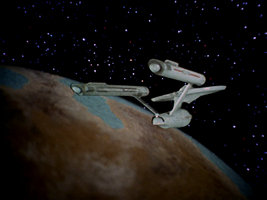
 USS Enterprise in TOS: "Turnabout Intruder"
USS Enterprise in TOS: "Turnabout Intruder"